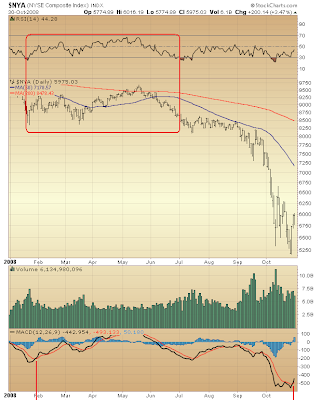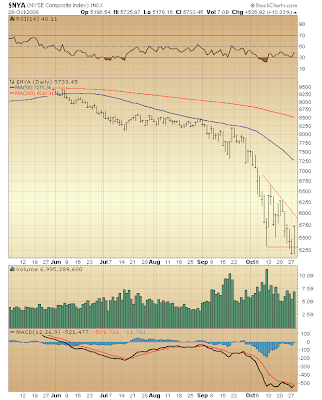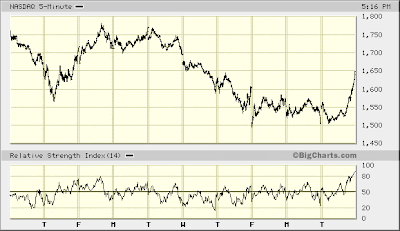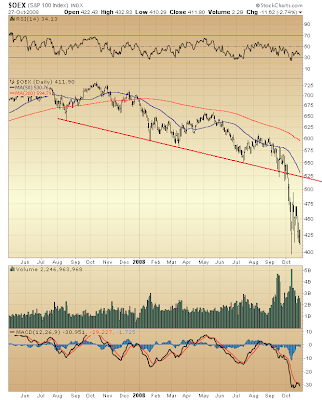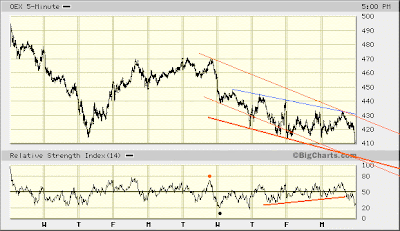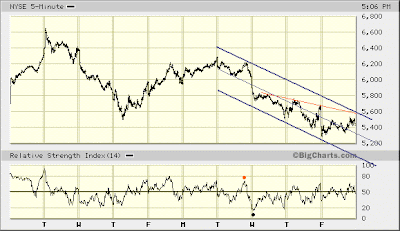Elliott Wave Analysis Update
I always say nothing is set in stone. And I will say it again because ... obviously ... Dow 3600 is by no means a slam dunk certainty. Truth is that's just life. Still, a fall to Dow 3600 sometime over the next few years remains a rather high probability.
Also true is this...
FACT: The stock market has reached a
very oversold condition.
Of course, this is a relative thing, and nothing set in stone says a very oversold market cannot soon collapse and become even more so. However, odds are against this.
Furthermore ... given how deeply oversold the market presently is ... given how unusually negative a multitude of underlying technical measures have become ... this Elliott Wave Guy strongly suspects the market's recent decline is a "third wave of a third wave" (typically the most dynamic of all Elliott Waves).
In other words, it is more likely an "impulse wave" in the direction of the main trend (down), rather than part of some "corrective wave" within this trend lower.
A "dynamic" move is powerful. It has the effect of lending greater analytical certainty to past and present market action, as well as confirm the unfolding trend. Obviously, the market's decline over the month of October well-qualifies, then.
A Confession
Not at any time over the course of this year did I ever suspect the market might decline to such a magnitude as we have seen. True, back in April-May I was bearish (as I have been all year). I argued a sell-off demonstrating "capitulation" likely would take out January/March '08 lows. But never did I imagine such a bloodbath coming so soon.
I bring this up because I say, "nothing is set in stone," yet I am just as susceptible as the next stock market analyst to taking a hard-and-fast view toward past performance and future probabilities. If there is anything I consider unwise in this game, it is holding too tightly to a forecast and doing everything to make the ever-unfolding evidence fit a given outlook at the expense of other viable alternatives. You see this all the time, no matter the observer's analytical framework — be it technical, fundamental, historical, statistical, whatever. The commentator almost seems "married" to a forecast, constantly presenting perspective lending credibility to a given outlook. In fact, I find this is more the rule than the exception.
And I am just as subject to this pitfall as the next person...
I am still kicking myself for missing the golden opportunity this recent decline presented. The monetary score trading stock index options could have been HUGE. I regret not perceiving the very conditions conducive to low-risk options play. Every time I look back to September I shake my head in disgust over not even seeing the possibility the market might collapse. It was all right there!Long-time readers
know I had a problem with the May 19th - July 15th decline. It simply was an analytical stretch arguing the much anticipating "capitulation" had, indeed, unfolded. The evidence was far from conclusive.
So, why was I not all over the possibility the market might crater?
I simply was "married" to one specific outlook among several possible alternatives en route to Dow 3600 sometime over the next few years. Indeed, this is the reason why I declared, "
Capitulation!" on September 15, 2008 (the day Lehman died).
Argh! Looking back at my analysis then, I was thoroughly fooled to think there was time for one screaming advance prior to collapse. Yeah, there was time alright ... all of two days (September 18-19).
Proof I was married to one specific outlook toward how Dow 3600 might likely be reached came Monday, September 29, 2008.
It was on this day index lows previously set on September 17th were taken out.
If ever there was an "Aha!" moment that should have been an indication something unusual — something unexpected — was developing ... this was it. I more or less thought 9.17.08 lows would hold. And I was unprepared for the possibility they might give way like a dry rotted floor.
This largely was because I gave primary focus to but one possible analytical view on how indexes might trace their respective declines to levels last seen in 1994.
What Went Wrong?
Probably most responsible for this has been the view I have taken toward the market's progress since the year 2000...

As you can see, I have not labeled the any of the components of wave
⓸. That's because I have been under the assumption this "corrective wave" still was forming. However, I should have been suspicious of this likelihood way back in late-2004 when the NYSE Composite reached a new, all-time record high.
Here's the deal. The
Elliott Wave Principle's "Rule of Alternation" provides guidance for setting expectations in all wave formations. Its most basic aspect can be applied to "corrective" waves, and states that no two sequential corrections of the same magnitude will ever be the same type.
Waves
⓶ and
⓸ are "corrections of the same magnitude." Wave
⓶ is a so-called "irregular flat" (and a special kind at that ... called a "running correction"). As such, then, the "Rule of Alternation" strongly suggests wave
⓸ will not form another "irregular flat."
Yet once the NYSE Composite reached new high ground late in 2004, odds increased wave
⓸ might be forming another "irregular flat." Granted, I have been assuming a different variation of an "irregular flat" might unfold ... and its complexity likely would differ from wave
⓶. Nevertheless, the "Rule of Alternation" suggests this outcome is improbable, because both waves
⓶ and
⓸ then would be forming the same
type of corrective wave.
Not giving this simple fact greater play probably is at the root of why I did not anticipate the stock market's recent collapse.Assuming the market was still in the process of correcting gains made from 1982-2000, I was constrained by a different set of probabilities most likely to develop at present.Let me cut right to the chase... Odds are the stock market's advance from 1974 probably completed in October 2007. I simply have not given this possibility much consideration until now. The fact weekly RSI has reached a sell-side extreme not seen in decades is proving the deciding factor driving my altered analysis of present circumstances.
True as it is I did not expect this, there it is nevertheless. So, change my view I must...

The one (and only) thing I do not like about this prospective view is the failure of wave
⓹ to reach the upper end of the NYSE Composite's price channel from 1974 (parallel red lines).
Supporting the above view, however, is the Elliott Wave Principle's guideline on "
wave equality"...
It is one of the tenets of Elliott wave theory that two impulse waves will always tend toward the same size in both time and price. It generally holds true for two non-extended waves and especially true if wave 3 is an extension.
Now, I have stretched this guideline a bit. Note the bars I have drawn showing price equality (black bars) and time equality (red bars) ... overlapping, first, impulse wave
⓵ and corrective wave
⓶ ... and then, corrective wave
⓸ and impulse wave
⓹. Is this legitimate? We will see.
But this new view solves the problem involving the "Rule of Alternation" of wave
⓸ relative to wave
⓶. The NYSE Composite's correction from mid-1999 through October 2002 is seen as a "triple three" with a declining bias. Indeed, wave
⓸'s declining bias might go some way toward explaining why wave
⓹ failed to reach the upper end of the price channel from 1974-2007.
Where Now?
Ever since concluding a market melt-up was no longer likely (see my "Outlook" of August 25, 2008 in the left column), I have been assuming the trip to Dow 3600 had begun,
and would likely unfold in five waves down from last October's peak. So, as recently as a few weeks ago, I was labeling the market's decline since October '07 as follows...

This assumed view on how Dow 3600 might be reached had me [wrongly] seeing the September 17, 2008 low as I did, and as well had me [quite possibly wrongly, too,] labeling the October decline as I did above on October 7th. As I said already, the severity of the market's October collapse has me seeing things slightly differently now.
Some time ago I mentioned how developments in the stock market (reflected by underlying technical conditions) take time to sink into my skull. That's because further developments often are needed before my initial interpretations are confirmed. This is particularly true when my analysis is challenged by circumstances.
The market's decline this month has proven one representative occasion. It has made more likely the following Elliott Wave interpretation...

At the start I indicated the intensity of the recent decline suggests a "third wave of a third wave" (typically the most dynamic of all Elliott Waves) is unfolding. While the Elliott Wave count on the above chart might not be definitive — it might be subject to slight change — it presents a fair representation of what this means. The market's collapse this month simply justifies this revision.
Furthermore, given the market's current, deeply oversold condition, the case for a bottom being near seems well-justified, too (why even from November 1929 through April 1930, half the losses realized during the 1929 crash were recovered).
So, according to this revised Elliott Wave view, waves
4 and
5 of
(c) are still to unfold. As this occurs it is safe to assume the five wave decline from May '08 forming wave
(c) likely will
channel as prescribed by the
Elliott Wave Principle.
Now, how much lower this might take the NYSE Composite remains to be seen. I suspect either a so-called "
fifth wave failure" might be in store, or wave
5 of
(c) will not fall much below wave
3 of
(c). Here is why...

This is the same longer-term chart of the NYSE Composite as was presented above, but drawn on arithmetic scale (rather than logarithmic). I have isolated the triangle forming wave
(4) of
⓷ and extended its boundaries forward through all the years since it formed.
At first glance this might seem an arbitrary and meaningless point of analysis. Yet there are Elliott Wave considerations worth pondering here...
In the matter of
Depth of Corrective Waves, the
Elliott Wave Principle states that, "
corrections, especially wave four corrections, tend to terminate within the range of the previous fourth wave of one lesser degree."
Might the NYSE Composite's wave
⓸ bottom in 2002 satisfy this guideline? If so, wouldn't it stand to reason the
first leg down following wave
⓹'s completion might end in this range, too? (The casual reader might not grasp what I am analytically suggesting here, but the Elliott Wave geek who has been around awhile will...)
What's Ahead?
As you know, I believe "
the Dow Jones Industrials could fall to 36oo tomorrow and still remain in a long-term uptrend." Let me show you why this is. You should appreciate this perspective...

Well, there you have it. In fact, the Dow could fall to 2000 tomorrow and remain in a long-term uptrend. Strange how talk of the Great Depression has become rather the rage these days...
So, now what?Well, this might come as a shock to some, but the market might rise toward all-time record highs over the months ahead. In the eyes of this Elliott Wave Guy — particularly in light of what just passed — a melt-up is entirely possible.
I am not saying new all-time records are likely. Instead, I am only suggesting they are possible.And while we're considering near-term possibilities, let's defer back to charts recently presented, showing upcoming objectives. The Elliott wave form assumed then might have slightly changed, but the indicated targets and direction quite possibly have not...
(This is a valuable aspect of Elliott Wave analysis. Not only can prospects often be usefully reduced to certain finite possibilities, but each alternative form ... different in some substantive way ... might point in the same direction, and portend a move of similar magnitude. You just can't beat that.)
First, there was the
long-term chart of the S&P 100 suggesting why you should "
Call Me the Chip Diller of Stock Market Analysts." Its purpose was to show why a sizable, upcoming bounce can be expected here. Weekly RSI screams, "All is well, remain calm."
Then, the next day I was "
Turning the Market Clock Back to 1973-1974" with a
long-term chart of the NYSE Composite showing how the price-RSI pattern of 1970-1974 bore a remarkable similarity to the 2002-present period. This was to suggest the worst is yet to come. Look again at this one. What if the present RSI dive is more like 1970's? This raises the possibility a launch to new-record levels might develop sometime over the months ahead before the market ultimately craters.
Which is to say I continue believing Dow 3600 could be reached sometime over the next few years, despite anticipating a rise toward all-time record levels quite possibly unfolding near-term...
* * * * *
© The Risk Averse Alert — Advocating a patient, disciplined approach to stock market investing. Overriding objective is limiting financial risk. Minimizing investment capital loss is a priority.
Analysis centers on the stock market's path of least resistance. Long-term, this drives a simple strategy for safely investing a 401(k) for maximum profit. Intermediate-term, investing with stock index tracking-ETFs (both their long and short varieties) is advanced. Short-term, stock index options occasionally offer extraordinary profit opportunities when the stock market is moving along its projected path.
Nothing is set in stone. Nor is the stock market's path of least resistance always known. More often than not, there are no stock index option positions recommended. There's an easy way to boost your investment discipline...
There's an easy way to boost your investment discipline...
Get Real-Time Trade Notification!
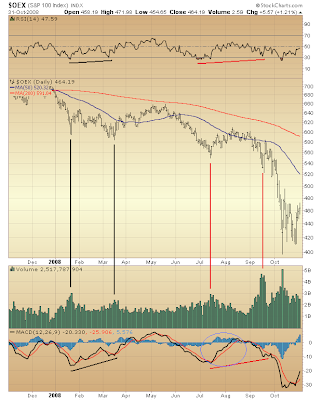
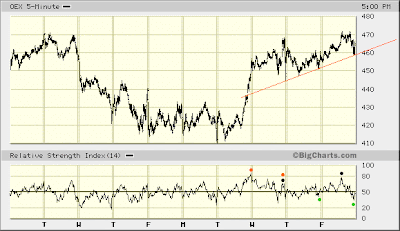

 There's an easy way to boost your investment discipline...
There's an easy way to boost your investment discipline...